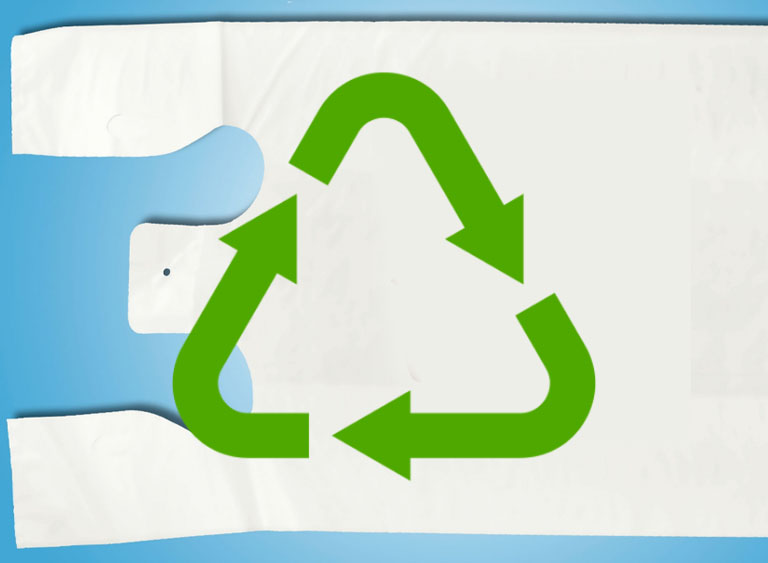Plastic bags have become a part of our daily lives. We use them for carrying groceries, shopping, and many other purposes. However, with increasing concerns over environmental pollution and waste, there has been a growing interest in eco-friendly alternatives, such as reusable bags. One of the most popular types of plastic bags is the PE t-shirt bag. In this post, we will provide a basic introduction to PE t-shirt bags, discuss how they are made, compare LDPE vs. HDPE bags, and explore their different applications. We will also look at how the waste or scraps of t-shirt bags occur and how to recycle them in-house.
What Are PE T-Shirt Bags?
PE t-shirt bags, also known as polyethylene t-shirt bags, are a type of plastic bag commonly used for carrying groceries or other items. They are called “t-shirt bags” because of their shape, which resembles a t-shirt with two handles at the top. They are often used by retailers and supermarkets as a low-cost packaging option for customers.
How Are PE T-Shirt Bags Made?
PE t-shirt bags are made from polyethylene, a type of thermoplastic polymer that is commonly used in packaging products. The production process for making PE t-shirt bags is relatively simple. It involves melting the polyethylene resin and extruding it into a flat tube. The tube is then cut to the desired length and sealed at the bottom to create a bag. The top of the bag is left open and reinforced with a plastic handle to make it easier to carry.
Types of PE T-Shirt Bags: LDPE vs. HDPE
PE t-shirt bags are available in two main types: LDPE and HDPE. LDPE stands for low-density polyethylene, while HDPE stands for high-density polyethylene. The main difference between the two types of bags is their density and strength.
LDPE bags are softer and more flexible than HDPE bags, which makes them easier to handle and fold. They are also more resistant to tearing and puncturing, which makes them ideal for carrying lightweight items such as groceries, clothing, and small household items.
HDPE bags are thicker and stronger than LDPE bags, which makes them more suitable for carrying heavy items such as bottles, cans, and other bulky items. They are also more resistant to heat and chemicals, which makes them a popular choice for industrial and commercial packaging.
Applications of PE T-Shirt Bags
PE t-shirt bags have a wide range of applications, from grocery shopping to industrial packaging. They are commonly used by retailers and supermarkets as a low-cost packaging option for customers. They are also used by manufacturers and wholesalers to package and transport their products. Here are some common applications of PE t-shirt bags:
- Grocery shopping: PE t-shirt bags are widely used by customers to carry groceries and other household items.
- Retail packaging: Many retailers use PE t-shirt bags as a low-cost option for packaging and transporting their products.
- Industrial packaging: PE t-shirt bags are also used by manufacturers and wholesalers to package and transport their products.
- Trash bags: LDPE bags are often used as trash bags because they are lightweight and easy to handle.
- Laundry bags: HDPE bags are commonly used as laundry bags because they are thicker and more durable than LDPE bags.
Waste or Scraps of T-Shirt Bags during Production
During the production process of t-shirt bags, the waste or scraps typically occur when the flat square bags are die-cut into the “T-shirt” shape. The leftovers from this process are considered waste materials and need to be dealt with appropriately to minimize environmental impact.
How to Recycle T-Shirt Bag Scraps
T-shirt bag manufacturers have two options for recycling their scraps. The first option is to do the recycling in-house using a PE plastic film recycling machine or a plastic granulator. This method requires the bag manufacturer to invest in the necessary equipment to turn the t-shirt bag scraps into reusable PE pellets. The pellets can then be added to the previous bag film production process, reducing waste and saving costs in the long term.
The second option is to sell the scraps in tons to a recycling center or ask the recycling center to handle the recycling process. The center will process the film scraps and return them as pellets. This method saves the bag manufacturer the initial investment in equipment, but the cost of transportation and the recycling center’s service fees should also be considered.
Comparison of Recycling Methods
The following table summarizes the pros and cons of each recycling method:
| In-House Recycling | Recycling Center | |
| Initial Investment | High | Low |
| Pellet Quality | High | Varies |
| Control | High | Low |
| Transportation Cost | Low | High |
| Service Fees | None | High |
| Labor Requirement | High | Low |
Overall, both options for recycling t-shirt bag scraps have their advantages and disadvantages. Onsite recycling offers more control over the recycling process and can result in long-term cost savings, but requires an initial investment. Selling to a recycling center does not require additional equipment, but may result in additional fees and less control over the recycling process. Ultimately, the choice depends on the specific needs and goals of the bag manufacturer.
Conclusion
PE t-shirt bags are a popular type of plastic bag used for carrying groceries and other items. They are made from polyethylene and are available in two main types: LDPE and HDPE. LDPE bags are softer and more flexible, while HDPE bags are thicker and more durable. They have a wide range of applications, from grocery shopping to industrial packaging. However, the waste or scraps generated during the production process is a huge waste to t-shrit bag manufactuers, can also contribute to environmental pollution if not handled of properly. The waste or scraps from t-shirt bag production can be recycled in-house as highly resuable pellets or sent to a recycling facility to be melted down and turned into pellets. By reducing waste and recycling plastic, the t-shirt bag manufacturer can turn waste into cash, and can all help to reduce our impact on the environment.

